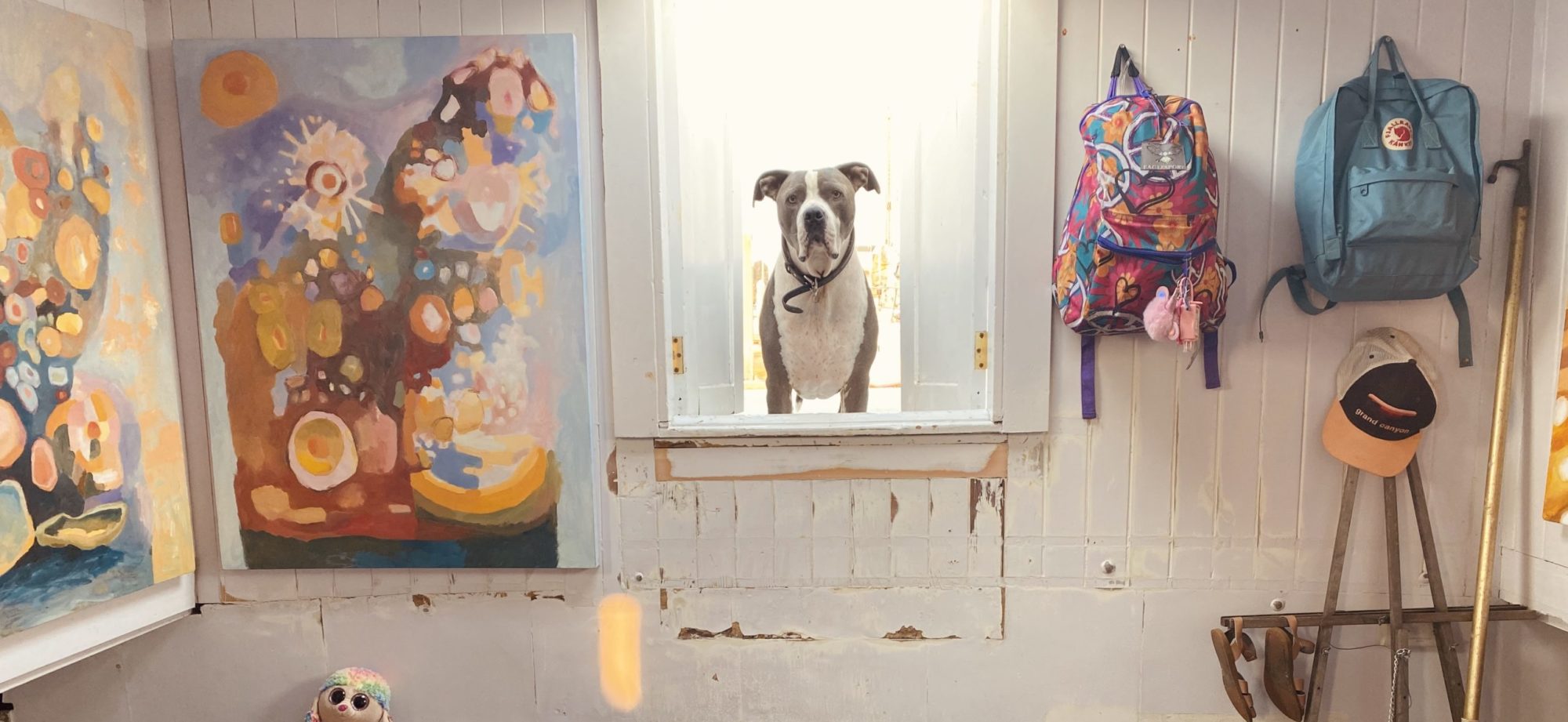I arrive in Houston at six o’clock, scarf down a plate of italian sausage and spaghetti and my parent’s house, and escort mom to the Gees Bend exhibit at the MFAH. We have an hour before the museum closes and I get momenntarily lost navigating my way to the museum’s new addition, through the same corridors I used to browse with a trail of small children in my teaching days at the Glassell School, across the street. It’s embarrassing and I smile to an Asian security guard who doesn’t seem to remember me this time.
The glossy terrazzo floor reflects little observational discussions, the tapping of fancy shoes and the muted cast of each bold, vibrant quilt in this collection. And boy, are they something. If the colors and assymetry of the quilts don’t immediately make you smile, look closer.
If you have a sensitive conscience, then you have questioned the way we live today: the overlooked luxury in each car parked in the driveway and the way you can choose your way each day, the piles of fashion magazines and the excess clothes, garages filled so full of crap because the house is spilling over and space is limited– this is the typical American family way of life (not that I am the exception) and this is a way of life that starves people of happiness and groundedness and peace. I think about this a lot and was brought to tears when I listened to an interview with one of the quilters as I scrutinized a soulful patch of denim in a quilt, a piece taken from a pair of worn-out blue jeans, that included the dark blue ghost of a pocket, the reminder of the fabric’s former life. I wanted to run my hands along the seams, feeling the backbone of handiwork and sweat and conversation that birthed these colorful objects. I cradled the idea of reuse, inspiring the happy purist in me.
I thought about the stiff smell of rows upon rows of fabric bolts, the angst of shopping for the perfect hue, specialty scissors and quilting stores with basketfuls of fat quarters in every imaginable print: cats drinking milk, cats dancing, cats pouring milk, cats stargazing, cats chasing balls of yarn, cats chasing mice, cats napping, cats making me dizzy with a cascade of possibilities, for some reason(pardon me if cats are your thing–and I still think cats are cool). I thought about my own sleeping, shelved monster of a fabric stash. I thought of the closetful of clothes in my bedroom that I will never wear again but refuse to give away, holding them for some special deconstruction but not finding the time just yet. And so they sit there, looking stale. And smelling about the same. I think I vowed right there to boycott the purchase of any more fabric from a store or supplier for a good, long time–at least until I can manage to recruit much of what I already have. You know the old adage, Waste Not, Want Not. I mean, I value the use of new fabric for projects (and man, can some of you SEW!) but for now, I will value myself more if I downsize.

Plummer Pettway 1918-1993 “Roman Stripes, variation (local name: “Crazy” Quilt) cotton twill, denim, cotton/ polyester blend, synthetic knit (pants matieral), 86 x 70 inches.
These isolated women had only the outgrown and worn-out clothes and bolts of local fabric (I think Sears once gave them bolts of the avocado fabric that shows up in nearly one hundred of the collection’s quilts). One of the quilters, in the interview I was listening to, struggled as she tried to convey what it was like not to have much of anything to work with. Work shirts, blue jeans, feed sacks–nothing was wasted. Nothing.
I smiled to read little excerpts about the children, sitting on the front porch beneath the quilting table, watching the needle poke through the underside of the quilt. I told Ford about the way the children (who became the artists of these quilts) picked up scraps of fabric that had fallen to the floor and began making little quilts of their own, right there on the floor. “We didn’t have much, but we was happy” echoed similarly among them. And I still get tears to remember one woman share her surprise in knowing that someone else besides herself appreciates them, not to mention put them up on a wall.

Missouri Pettway, 1902-1981. Blocks and strips work-clothes quilt, 1942, cotton, corduroy, cotton sacking material, 90 x 69 inches. Missouri’s daughter Arlonzia describes the quilt: “It was when Daddy died. I was about seventeen, eighteen. He stayed sick about eight months and passed on. Mama say, ‘I going to take his work clothes, shape them into a quilt to remember him, and cover up under it for love.’ She take his old pants legs and shirttails, take all the clothes he had, just enough to make that quilt, ahd I helped her tore them up. Bottom of the pants is narrow, top is wide, and she had me to cutting the top part out and to shape them up in even strips.” –both quilt images from Auburn Universitys: Quilts of Gees Bend in Context’s website.


I really, really wanted to touch these quilts too – quilts as much as anything, beg to be touched.
I bought the catalog which is full of art speak blah blah –but great pictures and a couple of wonderful essays at the end by some of the women — if you want to borrow it…
Oh, that would be wonderful, but I’m still kicking myself for not buying the book also. I can’t remember when an exhibit touched me this way.
Might take you up on that 🙂 …..
I’m kicking myself for missing these beauties when they were being shown at the Whitney. I always meant to go but stupid things got in the way and I missed it.
Steph, my mom wore dresses made from potato sacks when she was a very little girl. My great-grandma made many quilts and they are now extremely prized in the extended family. Alas, I do not have one.
But, I saved each nightgown that I wore while pregnant and nursing all five of my children. Hopefully, I’ll find someone to make a quilt for me from these precious fabrics. Quilts are truly special. Thanks for posting!
what an amzing exhibition!
Chrissy,
Do you know how to piece together a quilt? If you have a machine, it’d be easy for you to piece the quilt together like you want it, and then you can send the quilt off to have it bound. That’s such a special idea. I can’t part with my maternity clothes for that reason. I may shriek at the thought of another child to take care of (mine are so high-spirited) I weep at the thought of getting rid of those clothes, as if I’d be getting rid of that short part of my life that was so special to me in so many ways. I understand how you feel.
*steph
That’s a really good idea, Steph. And it wouldn’t be difficult to find some simple patterns or “blocks” to then sew together to make the front of the quilt.
The Gees Bend show was in Milwaukee when I lived in Madison and I too have kicked myself many a time for not going.
I remember seeing a TV piece about these quilters and quilts…quite touching. Having just returned from a week visiting my mother where (with her failing eyesight) she had me go through her entire (very large) wardrobe with her (“Does this still look okay?”)…I returned to my tiny place (with my tiny ‘wardrobe’…and I use the term loosely) thinking: maybe I won’t buy another item of clothing for the next year. I work at a school after all…I can wear jeans every day if I choose. I do have a sewing machine and it occurred to me that maybe I’d spend the next year spending money on things other than clothes (not that I spend much as it is). But I love the idea of simply using (and re-using) what’s already on hand. Your post has reinforced that thought. 🙂
I love these quilts more than I can say, and I am sure it is because there is so much of the quilter in every one of them. Just like this story. I try to follow their spirit as much as I can when I quilt. I haven’t quite got there and I am not sure I ever quite will, but it’s a worthy aim.